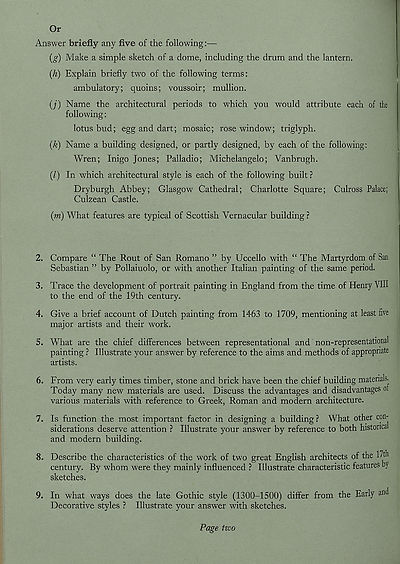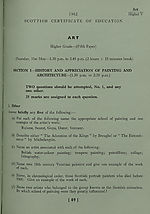Download files
Complete book:
Individual page:
Thumbnail gallery: Grid view | List view

Or
Answer briefly any five of the following:—
(g) Make a simple sketch of a dome, including the drum and the lantern.
(h) Explain briefly two of the following terms:
ambulatory; quoins; voussoir; mullion.
(j) Name the architectural periods to which you would attribute each of the
following:
lotus bud; egg and dart; mosaic; rose window; triglyph.
(k) Name a building designed, or partly designed, by each of the following:
Wren; Inigo Jones; Palladio; Michelangelo; Vanbrugh.
(/) In which architectural style is each of the following built ?
Dryburgh Abbey; Glasgow Cathedral; Charlotte Square; Culross Palace;
Culzean Castle.
(m) What features are typical of Scottish Vernacular building ?
2. Compare “ The Rout of San Romano ” by Uccello with “ The Martyrdom of San
Sebastian ” by Pollaiuolo, or with another Italian painting of the same period.
3. Trace the development of portrait painting in England from the time of Henry VIII
to the end of the 19th century.
4. Give a brief account of Dutch painting from 1463 to 1709, mentioning at least five
major artists and their work.
5. What are the chief differences between representational and non-representational
painting ? Illustrate your answer by reference to the aims and methods of appropriate
artists.
6. From very early times timber, stone and brick have been the chief building materials.
Today many new materials are used. Discuss the advantages and disadvantages or
various materials with reference to Greek, Roman and modem architecture.
7. Is function the most important factor in designing a building ? What other con¬
siderations deserve attention ? Illustrate your answer by reference to both historical
and modern building.
8. Describe the characteristics of the work of two great English architects of the 17th
century. By whom were they mainly influenced ? Illustrate characteristic features by
sketches.
9. In what ways does the late Gothic style (1300-1500) differ from the Early and
Decorative styles ? Illustrate your answer with sketches.
Page two
Answer briefly any five of the following:—
(g) Make a simple sketch of a dome, including the drum and the lantern.
(h) Explain briefly two of the following terms:
ambulatory; quoins; voussoir; mullion.
(j) Name the architectural periods to which you would attribute each of the
following:
lotus bud; egg and dart; mosaic; rose window; triglyph.
(k) Name a building designed, or partly designed, by each of the following:
Wren; Inigo Jones; Palladio; Michelangelo; Vanbrugh.
(/) In which architectural style is each of the following built ?
Dryburgh Abbey; Glasgow Cathedral; Charlotte Square; Culross Palace;
Culzean Castle.
(m) What features are typical of Scottish Vernacular building ?
2. Compare “ The Rout of San Romano ” by Uccello with “ The Martyrdom of San
Sebastian ” by Pollaiuolo, or with another Italian painting of the same period.
3. Trace the development of portrait painting in England from the time of Henry VIII
to the end of the 19th century.
4. Give a brief account of Dutch painting from 1463 to 1709, mentioning at least five
major artists and their work.
5. What are the chief differences between representational and non-representational
painting ? Illustrate your answer by reference to the aims and methods of appropriate
artists.
6. From very early times timber, stone and brick have been the chief building materials.
Today many new materials are used. Discuss the advantages and disadvantages or
various materials with reference to Greek, Roman and modem architecture.
7. Is function the most important factor in designing a building ? What other con¬
siderations deserve attention ? Illustrate your answer by reference to both historical
and modern building.
8. Describe the characteristics of the work of two great English architects of the 17th
century. By whom were they mainly influenced ? Illustrate characteristic features by
sketches.
9. In what ways does the late Gothic style (1300-1500) differ from the Early and
Decorative styles ? Illustrate your answer with sketches.
Page two
Set display mode to:
![]() Universal Viewer |
Universal Viewer | ![]() Mirador |
Large image | Transcription
Mirador |
Large image | Transcription
Images and transcriptions on this page, including medium image downloads, may be used under the Creative Commons Attribution 4.0 International Licence unless otherwise stated. ![]()
| Scottish school exams and circulars > Scottish Certificate of Education > 1962 > (328) |
|---|
| Permanent URL | https://digital.nls.uk/130810460 |
|---|
| Attribution and copyright: |
|
|---|---|
| Shelfmark | GEB.16 |
|---|---|
| Additional NLS resources: | |
| Description | Examination papers for the School Leaving Certificate 1888-1961 and the Scottish Certificate of Education 1962-1963. Produced by the Scotch (later 'Scottish') Education Department, these exam papers show how education developed in Scotland over this period, with a growing choice of subjects. Comparing them with current exam papers, there are obvious differences in the content and standards of the questions, and also in the layout and use of language |
|---|---|
| Additional NLS resources: |
|



